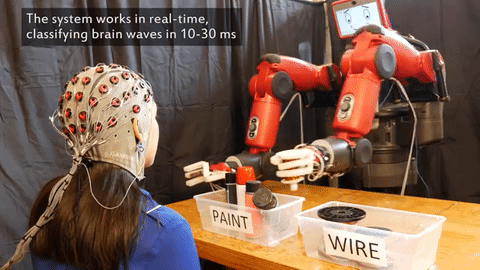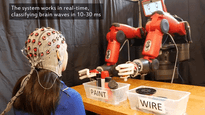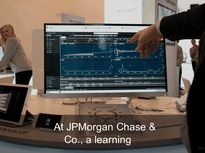
In this week's Abundance Insider: Mind-reading robots, cutting-edge cryopreservation capabilities, and an AI assistant that will save JPMorgan’s lawyers 360,000 hours a year.
Cheers,
Peter, Marissa, Cody, Kelley, Greg, Sydney and AJ
P.S. Exponential Manufacturing is now less than 60 days away, and Exponential Finance is less than 90. These two events will bring together global leaders to discover how the latest technologies are impacting manufacturing and finance, and will ensure each participant is prepared for the changes brought forth by unstoppable technological progress. Prices go up April 1st, so now is the time to take action, remove uncertainty and prepare for success in the year to come. Use code PHDATTEND for up to 15% savings on Exponential Manufacturing and Exponential Finance.
Baxter the Robot Fixes Its Mistakes By Reading Your Mind

What it is: Rethink Robotics' Baxter robot is helping human researchers develop techniques to communicate with robots on a less-awkward level. MIT roboticist Daniela Rus, co-author of this study, stated the goal for the research was to have the robot adapt to what the human would like to do. When humans notice a mistake, our brain emits an error-related potential signal. So when Baxter is about to make a mistake, the system translates these signals from the human's brain (which is connected to an EEG) into a code that Baxter understands. Researchers expect the current binary technology to expand across a range of detectable emotions in the future.
Why it's important: Socializing robots has been one of the primary challenges thus far between human-robot interactions, yet it's a critical one to address. Just as we saw in last week's Insider, Virginia's legislation passed the country's first delivery robot law, and other states have already begun preparing for the emergence of robots among society. These initial steps will continue to usher us toward a future of human-technology teamwork. | Join the Discussion
Spotted by Aryadeep S. Acharya / Written by Sydney Fulkerson
Meet Sedric, Volkswagen's Vision for Self-Driving Cars

What it is: Volkswagen recently unveiled an autonomous vehicle concept car called Sedric with no pedals, no steering wheel, and the ability to be summoned at the push of a button, much like a ridesharing service like Uber or Lyft. The ability to summon a vehicle is linked to a mobility ID, giving customers the ability to switch between their own personal vehicle to another in a different city. As this is a higher-level concept for VW, look for various elements to find their way into later concepts and production soon.
Why it's important: In addition to Tesla, ridesharing services like Uber and software companies like Google, nearly every major automaker also has an autonomous vehicle strategy or vision. With this increased competition, look for full-scale democratization of transportation services, safer streets, and unanticipated vehicle designs, services and business models to emerge. | Join the Discussion
Spotted by Aryadeep S. Acharya / Written by Jason Goodwin
Apis Cor 3D Prints a House in 24 Hours and Creates a Technological Showcase

What it is: In collaboration with property development company PIK, Apis Cor showed off its giant mobile 3D printer to construct a 38-square-meter 3D printed house in 24 hours. In addition to mobility around the construction site and an extruder able to rotate in two planes, the cranelike Apis printer can print both interior and exterior structures, rather than just the foundation. At about $275 per square meter, the Stupino house not only brings a significant reduction in the cost of construction, but also showcases the ability to design novel shapes, such as the nearly hurricane-windproof swirl seen here.
Why it's important: We're seeing an explosion in the number of applications for 3D printing and additive manufacturing, from objects as small and intricate as small as blood vessels to entire buildings, bridges and homes. In addition to the cost reductions from automation and resource use, we're also seeing novel structures and physics, from the circular home here to magnets with multiple fields. As these various techniques converge, anticipate not only faster responses after natural disasters, but a potential disruption in real estate and never-before-seen building designs. | Join the Discussion
Spotted by Jason Goodwin / Written by Jason Goodwin
New Research Could Turn Water Into the Fuel of Tomorrow

What it is: Scientists from the Department of Energy's Lawrence Berkeley National Laboratory and the California Institute of Technology have successfully doubled the number of potential photoanodes in just two years, which could revolutionize how we produce solar energy. Similar to the anodes in a battery, photoanodes activate the production of solar fuel by helping the process' flow of electrons. The researchers also discovered 12 candidates for new materials to use as photoanodes after calculating hundreds of theories with the help of resources at the National Energy Research Scientific Computing Center and Molecular Foundry. They then tested for anode activity using a novel high-throughput experimentation approach. The results from this research present us with more ways water can be used as an energy source.
Why it's important: Most coverage of solar has focused on electricity generation, but other exciting possibilities include fuels that might be incredibly attractive where battery storage is inadequate or impossible. As materials science becomes digitized, computation improvements are driving faster experimentation and new insights. Look for these high-throughput methods to have a huge impact in other disciplines. | Join the Discussion
Spotted by Aryadeep S. Acharya / Written by Sydney Fulkerson and Jason Goodwin
JP Morgan Software Does in Seconds What Took Lawyers 360,000 Hours

What it is: Citing competitive pressure, J.P. Morgan is investing heavily in software automation tools. A piece of that effort is COIN (for Contract Intelligence), a machine learning system designed to tackle the job of interpreting commercial loan agreements, a task that has historically consumed up to 360,000 hours of lawyer and loan officer time per year. Not only is COIN faster, reviewing documents in just seconds, it is far less error-prone and has reduced loan servicing mistakes in wholesale loan contracts. Building on this success, JP Morgan is looking for more ways to deploy the technology, including plans for complex legal filings like credit-default swaps and custody agreements, and possibly analyzing regulations and corporate communications.
Why it's important: We're seeing AI and machine learning tools applied to virtually any routine task, even those traditionally viewed as "white collar." Critically, J.P. Morgan and employees largely see this as a benefit, freeing them to work on more interesting and higher-value projects. As other incumbent firms like JP Morgan see pressure from disruptive startups, look for the rate of investment and innovation in AI technology and machine learning to increase. | Join the Discussion
Spotted by Aryadeep S. Acharya / Written by Jason Goodwin
Scientists Have Made a Huge Breakthrough In Cryogenics

What it is: Researchers at the University of Minnesota recently developed a new technique in cryopreservation -- the process of freezing organs and tissues at very low temperatures -- that could significantly reduce organ transplantation's logistical challenges. Cryopreservation is typically only successful among small samples, like sperm or embryos; however, scientists were able to cryopreserve human and pig organ samples, and then rewarm them successfully without damaging the tissue. The new technique involved mixing silica-coated iron oxide nanoparticles in a solution and then generating heat from applying an external magnetic field.
Why it's important: Over half of donated hearts and lungs are discarded each year due to the short timeframe the organs can be kept on ice. At the same time, 22 people die every day in the U.S. while waiting for organ transplants, according to the United Network for Organ Sharing. This cryogenics breakthrough could dramatically reduce this death rate and eradicate the organ transplant waitlist within three years. | Join the Discussion
Spotted by Jason Goodwin / Written by Sydney Fulkerson
What is Abundance Insider?
This email is a briefing of the week's most compelling, abundance-enabling tech developments, curated by Marissa Brassfield in preparation for Abundance 360. Read more about A360 below.
WANT MORE CONVERSATIONS LIKE THIS?
At Abundance 360, Peter's 360-person executive mastermind, we teach the metatrends, implications and unfair advantages for entrepreneurs enabled by breakthroughs like those featured above. We're looking for CEOs and entrepreneurs who want to change the world. The program is highly selective. Apply now for Abundance360 Summit if you'd like to develop an Abundance Mindset.
Know someone who would benefit from getting Abundance Insider? Send them to this link to sign up.
Topics: Abundance Insider







